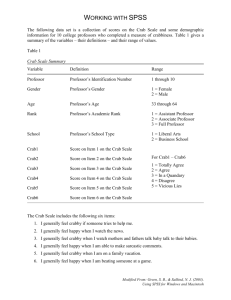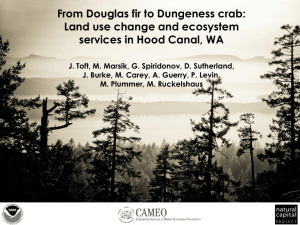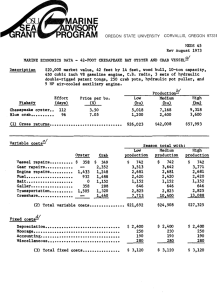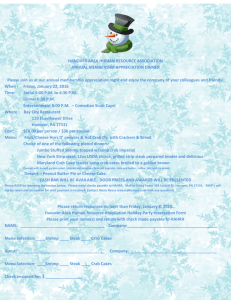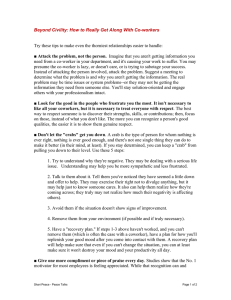Shellfish / Estuarine Habitat Projects DATA REPORT Marine Resources Program
advertisement
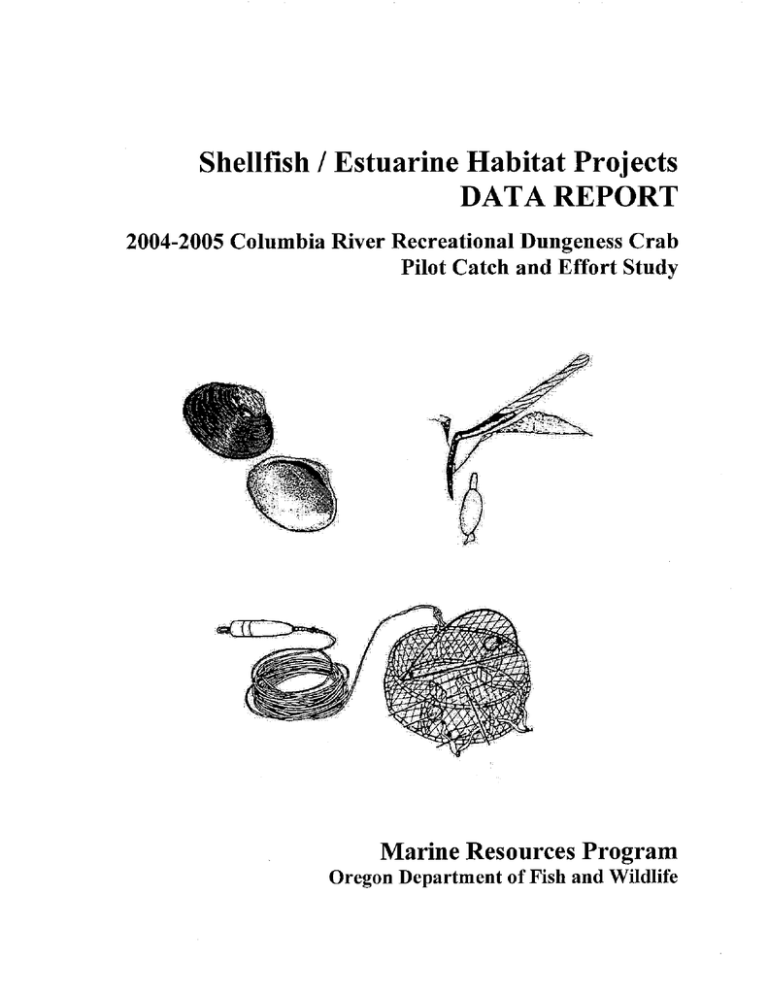
Shellfish / Estuarine Habitat Projects DATA REPORT 2004-2005 Columbia River Recreational Dungeness Crab Pilot Catch and Effort Study & Marine Resources Program Oregon Department of Fish and Wildlife 2004-2005 Columbia River Recreational Dungeness Crab Pilot Catch and Effort Study Christina Durham Matthew Hunter Oregon Department of Fish and Wildlife Marine Resources Program 2001 Marine Drive, Room 120 Astoria, Oregon 97103 August, 2008 Table of Contents Introduction . Methods SamplingArea ............................................................................................ . Catch and Effort Estimates .............................................................................. 1 1 1 1 BiologicalSampling ...................................................................................... 2 Results ...................................................................................................... 2 2004-2005 Catch and Effort ............................................................................. Released Dungeness crab ................................................................................ 2 3 Gear ......................................................................................................... 3 BiologicalData ............................................................................................ 4 Discussion ................................................................................................. 4 References ................................................................................................. List of Tables Table 1: Estimated catch and effort in Columbia River recreational Dungeness crab fishery, 2004-2005 ................................................................................ Table 2: Estimated number of released drabs, in three categories, by month, in the Columbia River recreational Dungeness crab fishery, 2004-2005 ............................. Table 3: Average amount of gear fished per person, by gear type, by month, in the Columbia River recreational Dungeness crab fishery, 2004-2005 ............................... List of Figures Figure 1: Estimated total catch per month in the Columbia River recreational Dungeness crab fishery, 2004-2005 ............................................................................... Figure 2: Catch per unit effort per week in the Columbia River recreational Dungeness crab fishery, 2004-2005 .................................................................................... Figure 3: Average crab carapace width per week in the Columbia River recreational Dungeness crab fishery, 2004-2005 ................................................................. 5 Introduction In 2003, the Oregon State Legislature, with substantial public support, established a recreational shellfish license in an attempt to increase enforcement, public outreach and education, and food safety practices on shellfish resources. According to a brochure distributed by the Oregon Department of Fish and Wildlife (ODFW), ". . the funds raised by the sale of shellfish licenses will allow a baseline program in each agency (ODFW, Oregon Department of Agriculture, and the Oregon State Police) to recoup information, resource management, and testing programs lost in the past." The recreational Dungeness crab fishery is one fishery that has never been comprehensively studied due to lack of resources and personnel. The Oregon Dungeness crab fishery is managed as a "3-5" (sex, size, season) recruitment fishery, which means that all males over the minimum size are legal to harvest during the entire year in bays and estuaries by recreational crabbers (Didier, Jr. 2002; ODFW 2001). Dungeness crab catch rates have fluctuated fairly cyclically over the past 30 years (Pauley et al. 1989) and not much is known about current stock abundances and their potential for sustainability. In 1988, ODFW staff conducted a study in Alsea Bay to evaluate recreational crabbing effort in the area (Demory and McCrae 1991); however the data collected were predominantly from a one-year period and lack of ifinding prevented further study. With the implementation of the recreational shellfish license in 2004, ODFW decided to reinitiate a study of the recreational component of the Dungeness crab fishery. The pilot study was performed to assess the effort and catch of recreational Dungeness erabbers on the Columbia River estuary during the fall and winter of 2004-2005. This project will hopefully be continued annually and possibly expanded on in the future to more completely assess this key component of the crab fishery. Methods Sampling Area Staff conducted random harvest interviews and performed effort counts on the Columbia River estuary, primarily at the Hammond boat basin in Hammond, OR (river mile 9). Initially, effort counts were also taken at the Warrenton boat basin in Warrenton, OR; however, more extensive sampling was not conducted at this site due to low or lack of effort. The Hammond boat basin is the largest access point on the Oregon side of the Lower Columbia Estuary. It is also the closest to the preferred harvest area for Dungeness crab which is south of an area between navigation buoys 21 and 25. This area is commonly referred to as Clatsop Spit. Catch and Effort Estimates Sampling consisted of interviews conducted between one and four times per week in the hour preceding and the two hours after high tide, regardless of weather and swell conditions. We had anecdotal information from recreational harvesters that, during this time period, effort was at its maximum. Sampling was conducted from October 1, 2004 to January 15, 2005. Staff availability and the lack of effort dictated the sampling time period. To estimate effort, staff counted empty boat trailers parked at the basin every hour during the interview process. Peak effort timeframes were determined from these counts to determine the total effort profile. Expansion factors were derived by using the area under the curve calculation of hourly effort counts, integrating sampling harvest time interview data and converting from harvester time to harvester numbers. From this data, we calculated a correction for effort efficiency of 0.85. All peak counts were divided by 0.85 to take into account effort outside of the peak count. The total crabber effort calculated for the week used the average of the maximum effort for the days sampled and expanded it to include the days of the week not sampled. The sampling methodology of this project is similar to most creel studies performed by ODFW staff crabbers on boats, both recreational and charter were interviewed when landing at the boat basin. Sample interviews were taken on weekdays only. Weekend effort counts were taken four times, in October only, on one day per weekend. Ratios of weekday to weekend activity were established from these counts and applied to correct the weekly totals for the rest of the study period. The weeks of December 20th and January 3rdj were not sampled due to scheduling conflicts. The average effort for the week of December 20th was estimated using effort counts from the four other sampled weeks in December. The average effort for the week of January 3rd was estimated using effort counts from the week before and the week after. The following information was collected from each boat interviewed: the number of hours spent crabbing that day, the number of crabbers on the boat, the number and type of gear (pots or rings or both) used while crabbing that day, the number of times the gear was pulled in, the number of legal size (? 5 ¼ in or 146 mm) crab kept, the approximate number of females and undersized male crab released, as well as the number of legal sized crab caught and released after the daily bag limit of 12 per crabber was attained. As many crabbers as possible were interviewed each day. Biological Sampling A random sample of approximately 50 crab per week from different interviewed vessels was measured for individual carapace width. These crab were also assessed for shell hardness and for wholeness (i.e. was the crab missing any claws, legs, or both). Results 2004-2005 Catch and Effort Total crab harvest and effort for the sampling season was estimated to be 83,901 crab from an estimated 8,561 crabbing trips (Table I). Catch per unit effort per week was fairly consistent over the course of sampling (Figure 2), ranging from 7.10 crab per crabber the week of October 25th to 11.70 for the week of October 18th The weekly CPUE was generally between 8 and 10 crab per person and averaged 9.80 crab per crabber for the season. Weekly, monthly, and seasonal totals and averages were estimated for the following categories: total crabber effort, average catch per crabber, and total catch per week and per month (Table 1, Figures 1 and 2). November had the lowest total effort; however, this can partially be attributed to bad weather and high swells during the week of November l which produced the smallest effort seen over the entire course of the study period. Despite this decreased effort, the estimated total catch for the month was similar to that of October due to an increase in average catch per crabber (from 9.66 crab per person in October to 10.64 in November). Even though average catch per crabber was the lowest overall in December (9.41 crab per crabber), effort was highest because of the scheduled this month; a month usually having little to no recreational effort 1g Estimated total catch for opening of the commercial Dungeness crab season on December December exceeded 30,000 crab. Released Dungeness Crab A total of 20,895 legal male, 39,723 female and 82,387 sublegal crab were released during the sampling season (Table 2). Harvesters are required to release all females and undersized male crab. In addition, at times they release the legal males in the process of "high-grading" their catch. Meaning that they released legal crab that were soft-shelled, had missing appendages or were smaller other legal crab harvested. In January, sampling was conducted in only half the month due to the beginning of the commercial crabbing season which added competition for crab harvest which contributed to lower recreational effort and numbers of crab harvested, and inclement weather conditions not suitable for small recreational vessels. Crabbers released the greatest number of legal males gust over 9,000) in October. The number of legal males released decreased in subsequent months with the lowest in January. October and December had similar numbers of released females and undersized male crab (between 14,000 and 15,500 released females and around 30,000 released undersized males), while November had around half of the numbers in each category (6,956 and 12,215, respectively). Lower numbers of females and undersized crab released in November could be affected by the life history or reproductive effort of Dungeness crab during this period, however, not much information is known regarding either of these topics. More studies in subsequent years are necessary to attempt to explain trends in this data set and to determine if these data reflects yearly trends. Gear Pot gear was utilized more prevalent overall, with a season average of 1.48 pots per crabber (Table 3). Rings, which need much more attention during fishing, were less popular, averaging 0.38 rings per person for the season. It should be noted that combining the two columns, pots and rings, for each of the four months always results in a combined average of less than 3, which is the maximum number of gear allowed per crabber. This indicates that, on average, most crabbers surveyed did not use the maximum number of gear allowed. Biological Data Staff measured carapace widths (cw) during 11 of the 16 weeks, collecting 50 measurements per week. A total of 394 individual crab were measured for carapace width, missing appendages, and shell hardness. The average carapace width was 169.1 millimeters (about 6 5/8 inches) well over the recreational and commercial minimum sizes of 5 ¼ and 6 ¼ inches, respectively. The majority of the crab sampled (82.2%) were not missing any appendages and the majority were categorized as having hard shell hardness (88.3%). Crab appeared to have a similar average size for the first eight weeks sampled (Figure 3). The weeks of December 20th and 27th showed approximately a 2 mm drop in average size (from 166 mm cw to between 163 andl64 nmi cw). The size did rebound however, with the largest crab sampled occurring in the month of January with an average carapace width of 172.7 mm. These results need to be examined further to determine if there is any reason behind the slight increase in size of crab caught in January. This time does not generally coincide with a molt cycle (Armstrong et al., 1981), so results need to be further examined and verified in subsequent study years. Discussion These results may not be indicative of a typical recreational crabbing season for a few reasons. An important factor in recreational effort and harvest in the past has been the relative amount of major fall and winter storms and theft associated swell and freshwater influx to the river. Storms can create hazardous water conditions that limit recreational effort, while the influx of freshwater can push crab out of the estuary and into the ocean (Johnson, 2002). Both of these components have the ability to decrease the number of crab harvested. The fall and winter of 2004/05 was relatively dry and devoid of such storms, which normally occur at that time of year. This factor alone probably had a significant effect on crabbing effort and crab availability. All of the data gathered in this study should be compared with future surveys over multiple crabbing seasons to draw conclusions on overall recreational crab catch and effort. An additional effect on harvest and effort for this year was an almost seven week delay of the opening of the commercial crab season because of low pick-out test results for almost 7 weeks. This extended closure provided us with a unique opportunity to collect data from December Vtto January 15th Anecdotal information has previously indicated that after the beginning of the commercial crab season, the recreational crabbing effort in the Columbia River estuary drops off almost immediately to minimal numbers. Normally, when the commercial season opens, crab are caught so quickly by the commercial boats that most recreational crabbers do not make the effort to try to crab themselves, as it would invariably take them more time to harvest the same amount of crab at this time as it would take them in October or November. While the first eight weeks of this study represents data that can be subsequently collected every year, the last seven weeks consist of unique data that will hopefully give us a different view of Dungeness crab activity without commercial fishing pressures for a longer period of time in the year. We hope this study will be expanded in the future to a year-round creel survey of the recreational Dungeness crab fishery. It is vital to have this and other historic catch data to monitor population trends and generate estimations of economic value for the recreational river/estuary crab fishery. It is only with information that we can understand this important fishery and hopethily this study will begin an ongoing program of research on Dungeness crab. References Armstrong, D.A., B.G. Stevens, and J.C. Hoeman. 1981. Distribution and Abundance of Dungeness Crab and Crangon Shrimp, and Dredging-Related Mortality of Invertebrates and Fish in Grays Harbor, Washington. Washington State Department of Fisheries Technical Report. Deniory, D. and I McCrae. 1991. Alsea Bay Sport Crab Survey, 1988-89. Oregon Department of Fish and Wildlife Marine Region. Newport, OR. Didier, Jr., A.J. 2002. The Pacific Coast Dungeness Crab Fishery. Submitted to: Committee on Commerce, Science and Transportation of the United States Senate and Committee on Resources of the United States House of Representatives. Pacific States Marine Fisheries Commission. Gladstone, OR. Johnson, J.A. 2002. Clam Digging and Crabbing in Oregon. Waldport, OR: Adventure North Publishing Company. 104 pp. ODFW. 2001. Dungeness Crab. In: Oregon marine Fisheries 2000 Status Report, Oregon Department of Fish and Wildlife Marine Resources Program, Newport, OR Pauley, G.B., D.A. Armstrong, R. Van Citter, and (ILL. Thomas. 1989. Species Profiles: Life Histories and Environmental Requirements of Coastal Fishes and Invertebrates (Pacific Southwest)--Dungeness Crab. U.S. Fish and Wildlife Service Biological Reports 82(11.121). U.S. Army Corps of Engineers, TR EL-82-4. 20 pp. Table 1. Estimated catch and effort in Columbia River recreational Dungeness crab fishery, 2004-2005. Total crabber effort Average catch / Week beginning Total catch I week (# of people) crabber 4-Oct-04 11-Oct-04 18-Oct-04 25-Oct-04 October Total 725 613 643 356 2,337 8.72 11.10 11.68 7.07 9.91 6,325 6,807 7,509 2,517 23,158 1-Nov-04 8-Nov-04 15-Nov-04 22-Nov-04 November Total 102 10.54 10.59 10.37 11.01 10.68 1,075 11,276 2,561 6,498 21,410 641 461 1,293 10.18 9.71 9.39 8.90 8.84 3,299 9.30 7,116 2,001 6,021 4,104 11,424 30,666 738 921 9.07 10.77 9.41 6,697 1,970 8,667 8,561 9.80 83,901 29-Nov-04 6-Dec-04 13-Dec-04 20-Dec-04 27-Dec-04 December Total 3-Jan-05 10-Jan-05 January Total Total 1,065 247 590 2,004 699 206 183 Table 2. Estimated number of released crabs, in three categories, by month, in the Columbia River recreational Dungeness crab fishery, 2004-2005. Month Undersized Females Legal crab October 9,254 15,313 35,114 November December January 5,064 6,956 12,215 4,675 14,387 28,378 1,902 3,067 6,680 20,895 39,723 82,387 Total Table 3. Average amount of gear fished per person, by gear type, by month, in the Columbia River recreational Dungeness crab fishery, 2004-2005. Month Pot gear Ring gear 1.44 0.52 1.40 0.37 October November December January 1.55 0.29 2.00 0.18 Season Average 1.48 I 0.38 35000 30000 25000 U 'S 20000 E 15000 C 10000 5000 0 Figure 1: Estimated Total Catch Per Month in the Columbia River Recreational Dungeness Crab Fishery, 2004-2005. 14 12 (0 .0 o 10 0 0 0 0. U (0 U 2 3 4 5 6 7 8 week (#) 9 10 11 12 13 Figure 2: Catch per unit effort per week in the Columbia River Recreational Dungeness Crab Fishery, 2004-2005. 8 14 15 174 ti-I 170 Li 1168 fl- 50) - H i -i, 4 H rr 166 164 : ri FH1 162 160 1 2 3 4 5 6 7 8 0 10 11 12 14 15 16 week# Figure 3: Average Crab Carapace Width Per Week in the Columbia River Recreational Dungeness Crab Fishery, 2004-2005.
